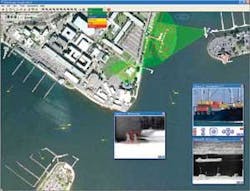Department of Homeland Security officials are procuring and developing technology to secure the nation’s borders and prevent terrorists and weapons from getting through.
By John McHale
Today’s news is filled with stories about how porous the U.S. borders with Canada and Mexico are, and how easy it is for terrorists to slip through where they potentially could wreak havoc.
More than 500 million people cross U.S. borders every year, including 330 million noncitizens. Commerce and industry boost that traffic, as 11.2 million trucks and 2.2 million rail cars cross our borders annually.
That is just the tally of traffic through 350 official ports of entry. Between those legal border crossings lie vast expanses of open space-the U.S. shares 5,525 miles of border with Canada, and 1,989 miles with Mexico.
Those vast numbers mean that border agents cannot possibly check every car or every traveler. U.S. Department of Homeland Security (DHS) officials, therefore, are relying on new technologies to tighten the country’s borders.
The Office of Customs and Border Protection is the main arm of the DHS for border security.
Experts at the Civitas Group in Washington, a firm that specializes as a liaison between the Homeland Security Department and private businesses, say there are two main types of border security. First is strict border surveillance like the Arizona border, and the second is points of entry like airports and seaports.
Typically, the goal of border security is to prevent entrance to illegal aliens and terrorists, says Rick Gordon, vice president of the Civitas Group. It is possible to control the borders thoroughly though technology, but political considerations such as the right to privacy can get in the way, Gordon points out.
Points of entry require credentialing technology such as smart cards, biometrics, and risk-management tools that allow operators of security terminals access to several kinds of biographical or biometric information and compare it to multiple databases such as the FBI’s Automated Fingerprint Identification System, or AFIS.
Currently, fingerprints are the main biometric choice; however, new passports may have embedded chips that store a digital image of a person’s face in addition to a fingerprint, Gordon says. Although this change is still basically the same as a customs agent or security officer checking a regular photograph, eventually it will lead to some type of facial recognition, he explains.
There is still a 5 percent failure-to-enroll rate with fingerprints but no other biometric is as efficient overall, Gordon says. Typically, the DHS officials require all 10 fingerprints to be taken because the more fingerprints, the easier it is to find a match, Gordon says.
Another technology for port of entry is millimeter-wave RF technology, which can see through clothing and can spot concealed weapons, Gordon says.
One of the companies specializing in technology for securing points of entry, Markland Technologies Inc. in Ridgeland Conn., completed repairs and improvements to the Secure Electronic Network for Travelers’ Rapid Inspection (SENTRI) system at the heavily traveled U.S. border crossing with Mexico in San Ysidro, Calif.
San Ysidro, Calif., across from Tijuana, Mexico, is less than 20 miles south of downtown San Diego, and is the world’s busiest port of entry. On an average day, more than 40,000 vehicles pass through.
The SENTRI system at San Ysidro processes prescreened vehicles and low-risk travelers from Mexico in an expeditious manner through dedicated travel lanes, Markland officials say.
Recent work by Markland’s wholly owned subsidiary Ergo Systems included the installation of new roadway-embedded sensors, tire shredders, and exit gates. These repairs and improvements improved the security and traffic flow of vehicular traffic entering the United States from Mexico.
The Massachusetts Port Authority (Massport) is using VistaScape’s SiteIQ surveillance platform to protect Logan International Airport and Massport maritime properties located in and around Boston Harbor. The announcement follows a pilot project at Logan Airport in May 2003.
Massport selected the ADT Security Services Federal Systems Division, a unit of Tyco Fire & Security based in Boca Raton, Fla., as the prime contractor and systems integrator, responsible for installing the SiteIQ software, surveillance cameras, and other security infrastructure. ADT’s Federal Systems Division is in Alexandria, Va. Ross & Baruzzini Inc. in St. Louis is providing the architecture design and engineering services for the project.
SiteIQ software provides a graphical display for monitoring activity across an entire area, based on input from surveillance cameras and other sensors. Rather than relying on guards to monitor several video displays, SiteIQ uses geo-enhanced video analytics to plot detected activity in real time on a 3-D world model. SiteIQ detects, tracks, and classifies objects onscreen and, if a security rule is violated, automatically alerts authorities with audible alarms and live video of the event.
“VistaScape’s software extends our eyes far beyond the reach of conventional surveillance systems,” says Dennis Treece, director of corporate security for Massport. “This means a more productive and effective security staff for Massport, which translates into a higher level of safety and service for our passengers, commercial customers, and the general public.”
Among the camera technologies from ADT is an infrared camera from Hurley & Associates for high-resolution video imagery at night and in bad weather. In addition to the fixed camera infrastructure, Massport will receive a deployable detection device that extends coverage to new areas of concern.
Nuclear materials detection
The majority of the research coming out of HSARPA and the DHS is for detecting and dealing with radioactive threats, Gordon says. It is a top priority for DHS. Some equipment is already in use but not nearly enough, he says.
The biggest problem with these devices is the number of false alarms, according to Gordon. Minor radiation from a watch or even from granite particles often will set it off. A person can become more radioactive in the granite mountains of New Hampshire than on a nuclear submarine, Gordon points out.
DHS Secretary Michael Chertoff announced this spring that the nation’s busiest seaports-Los Angeles/Long Beach, Calif.-will have complete radiation portal monitor (RPM) coverage by year’s end.
Three terminal locations, at Piers 400, 300, and Trans Pacific, within the Port of Los Angeles are scheduled to go online by the end of June. A total of 90 RPMs, which will screen all international container traffic and vehicles exiting the facility, for nuclear materials or hidden sources of radiation, will be operational by December 2005.
RPMs provide U.S. Customs and Border Protection (CBP) officers with a passive, nonintrusive means to screen containers, vessels, or vehicles for the presence of nuclear and radiological materials. These systems do not emit radiation but are capable of detecting various types of radiation emanating from nuclear devices, dirty bombs, special nuclear materials, natural sources, and isotopes commonly used in medicine and industry.
“By applying advanced technology, we will soon be able to screen every vehicle and container entering the nation’s busiest seaports for nuclear and radiological materials, without disrupting the free flow of trade. Complete and efficient coverage at the LA/Long Beach seaports is a major step forward for national security and a model for other ports,” Secretary Chertoff says.
DHS implements a multilayered strategy for screening cargo shipped to the U.S. One such layer is the installation of RPMs at seaports, land border ports of entry, and crossings nationwide, including rail crossings, international airports, and international mail and express consignment courier facilities, in an effort to screen 100 percent of all incoming goods, people, and conveyances for radiation.
In April, maritime facilities at the Port of Oakland, Calif., became the first seaport in the country to have complete coverage. RPMs at the LA/Long Beach seaports will complement existing cargo security measures to include five mobile gamma ray and two x-ray scanners, personal radiation detectors, and isotope identification devices.
The LA/Long Beach seaports receive approximately 44 percent of all sea cargo destined for the U.S. More than 4.3 million foreign cargo containers arrived at the LA/Long Beach seaports last year-an average of one container every seven seconds.
In April DHS officials also extended the department’s contract with the ORTEC business unit of AMETEK to include the fast-track development and delivery later this year of two prototypes and other related hardware for an Advanced Spectroscopic Portal Monitoring System.
The $3.1 million contract extension follows a first-stage contract awarded by HSARPA in January to AMETEK to develop the system, which will screen passengers and cargo for potentially harmful shipments of radioactive materials that could be used in a nuclear device or “dirty bomb.”
The prototype systems will incorporate arrays of ORTEC high-purity germanium detectors coupled with several unique and novel techniques to process and present data collected from possible gamma and neutron radiation emanating from pedestrians, vehicles, or freight containers. The systems will be able to quickly determine whether a source is “innocent,” such as naturally occurring radioactive materials and medical isotopes, or “suspicious” and poses a potential terrorist threat to safety or security.
The greatest biological threat in Gordon’s mind is a terrorist firing a rocket-propelled grenade into a chlorine tank, he says. “They don’t even need an RPG, all they need to do is blow it up,” he adds.
iControl wins DHS contract for container security
Officials at the U.S. Department of Homeland Security awarded a Phase II Marine Asset Tag Tracking System (MATTS) contract to iControl Inc.
MATTS is part of the Future Smart Container initiative, which establishes the architecture and standards necessary to secure shipping containers from the factory to the warehouse. Phase II culminates in the demonstration of iControl’s solution in a global operating environment.
While industry has focused on supply-chain management and “port-centric” communications, iControl’s MATTS solution will provide Homeland Security and first responders with “anytime, anywhere” access to a container’s status, iControl officials say.
“Managing the supply chain is not the same as securing the supply chain,” says iControl’s MATTS program manager, Diane Quick. “Terrorists do not fill out manifests or use RFID tags on their shipments. A compromised container is a threat not only to ports, but also to urban areas and critical infrastructure it passes while in transit. Securing populations, property, and economies requires continuous container tracking and monitoring.”
The MATTS architecture consists of container tags, gateways, and a Data Center. iControl’s use of its existing commercial products as a baseline for the MATTS solution substantially reduced cost, risk, and development time, company officials say.
“The MATTS program requirements represent a challenging, yet logical extension of our commercial product capabilities,” says Fred Tubb, iControl’s chief executive officer. “During Phase II, iControl’s container tracking device will be deployed as a miniaturized System-On-Chip (SOC) design. It provides substantially superior processing, communication range, and worldwide tracking capability when compared to RFID technologies. Strategically, we have chosen international standards to improve overseas adoption, to speed deployment, and to minimize installation.”
For more information visit www.icontrol-inc.com.
Coast Guard signs BAE Systems to provide port security
Officials at the U.S. Coast Guard’s Research and Development Center selected BAE Systems in Burlington, Mass., to build the SeeCoast Port and Coastal Scene Awareness Prototype and Demonstration System.
The program, valued at $3.3 million including options, is part of the Department of Homeland Security’s (DHS) Advanced Research Projects Agency (HSARPA) Automated Scene Understanding program.
The SeeCoast system will integrate radar track data, video image streams, positioning information from an Automatic Identification System (AIS), and other data inputs, to provide machine understanding of the coastal and port security scene and enhance vessel detection, evaluation, and tracking in support of tactical analysis and intercept decisions.
SeeCoast will leverage existing BAE Systems capabilities in video processing, track correlation and fusion, rule-based alerting, and visualization. It will use advanced learning methods based on human cognitive processing models to enable continuous, on-the-fly learning of anomalous activities.
SeeCoast will be installed in the DHS Hawkeye test bed at the Portsmouth, Va., and Miami Coast Guard Sector Command Centers during the first 12 months of the contract.
For more information, see www.na.baesystems.com.
U.S. Customs and Border Protection selects EMS satellite communications technology for P3 aircraft
Officials at the U.S. Customs and Border Protection Branch of the Department of Homeland Security successfully flight-tested the eNfusion Broadband communications solution from EMS SATCOM in Ottawa, Ontario, earlier this year. Equipment tests took place aboard a P3 Orion multimission aircraft.
“EMS SATCOM is able to provide the most bandwidth over the global Inmarsat satellite network, and is ideal for the variety of missions that the P3 aircraft performs,” says Stephen Newell, director of government sales for EMS SATCOM. “Bandwidth-on-demand provides the most cost-effective use of this system.”
The U.S. Customs and Border Protection P-3 Orion Aircraft, based in Corpus Christie, Texas, are primarily used for detection, monitoring, and interdiction of drug trafficking in Central and South America. An aircraft equipped with EMS SATCOM’s eNfusion Broadband communications system uses the combination of an EMS SATCOM HSD-128 (high-speed data terminal), two HSDX’s, and an AMT-50 Antenna and radome, to produce 256 kilobits per second of communications bandwidth.
A key feature is the system’s ability to automatically turn channels on and off, based on communication requirements-making contact with the command center virtually seamless, company officials say. The single most important advantage of the solution is immediate access to information-for better decisions and faster reaction times.
The HSD-128, a broadband communications terminal, provides secure access to VPNs, and delivers e-mail, videoconferencing, and Internet.
The AMT-50 antenna is a high-gain Aero-H/H+ multichannel antenna that is lightweight, tail-mounted, and reliable. It provides hemispherical coverage, with no keyholes or gaps, EMS officials say.
The HSD-X data extension is an add-on module that provides additional speed to the HSD terminal’s throughput. The HSD-400 line will support CNS/ATM and evolving SwiftBroadband services.
EMS’s CNX cabin network accelerator is a special-purpose, aircraft-certified network solution that combines data acceleration, routing, inverse multiplexing, ISDN, terminal adapter, Ethernet hub, and telephony support. It increases Satcom network throughput by as much as 400 percent, providing high-speed connectivity to and from the air, company officials say.
For more information visit www.emssatcom.com.
ObjectVideo wins DHS contract for video surveillance
ObjectVideo in Reston, Va., has won two contracts totaling as much as $3.2 million over the next three years from the Homeland Security Advanced Research Project Agency (HSARPA) to develop next-generation capabilities for intelligent video surveillance systems.
HSARPA officials selected ObjectVideo from more than 50 companies and awarded it two of the four contracts available to study “Automated Scene Understanding,” ObjectVideo officials say.
The public and private sector have deployed sophisticated security networks that utilize closed-circuit television (CCTV), specialized video and infrared cameras, radars, and other sensors to provide physical security and general awareness at critical infrastructure, transportation hubs, borders, ports, harbors, industrial sites, and other key locations. However, these systems can overload operators with data, increasing the chances of the systems being ignored, mismanaged, or rendered ineffective, company officials say.
HSARPA has contracted with ObjectVideo to address this problem by enriching intelligent video surveillance systems with smarter capabilities including automated threat awareness and dynamic adaptability-capabilities that are useful in a highly dynamic environment, such as an airport or seaport, where planes and freighters are continually moving in and out of the scene and may not appear in the same area twice.
Instead of monitoring an “area of interest” on a continual basis, this next-generation system recognizes specific mobile assets, understands what rules apply to them, and automatically adjusts to protect them, no matter where they appear. It does all of this without a systems operator intervening.
The benefits of this capability are a much higher level of protection, fewer false alarms, and smarter use of manpower because it frees the operator from having to constantly set and re-set rules to keep up with the variations in movement of mobile assets.
“HSARPA is seeking to amplify the effectiveness of vital security systems by taking a key component of those systems-intelligent video surveillance-to the next level,” says Dr. Alan Lipton, chief technology officer of ObjectVideo.
ObjectVideo’s intelligent video-analysis algorithms, based on artificial intelligence called “computer vision,” run all objects in a camera’s view against pre-programmed rules. When an object violates a rule-for example, a small boat loiters next to a ship, a bag is left unattended in an airport terminal, or a shopper displays characteristics of shoplifting-the software alerts security personnel by phone, pager, e-mail, or an alert console.
Customers of ObjectVideo’s technology include the Department of Homeland Security’s Customs and Border Protection Bureau, the Department of Defense, the U.S. Air Force, the Department of Energy, the Port of Jacksonville, Port Everglades, Miami International Airport and a variety of private-sector businesses.
ObjectVideo markets and sells its products through a VIP partner program of leading security companies on digital signal processor and server platforms. For more information, see www.objectvideo.com.







